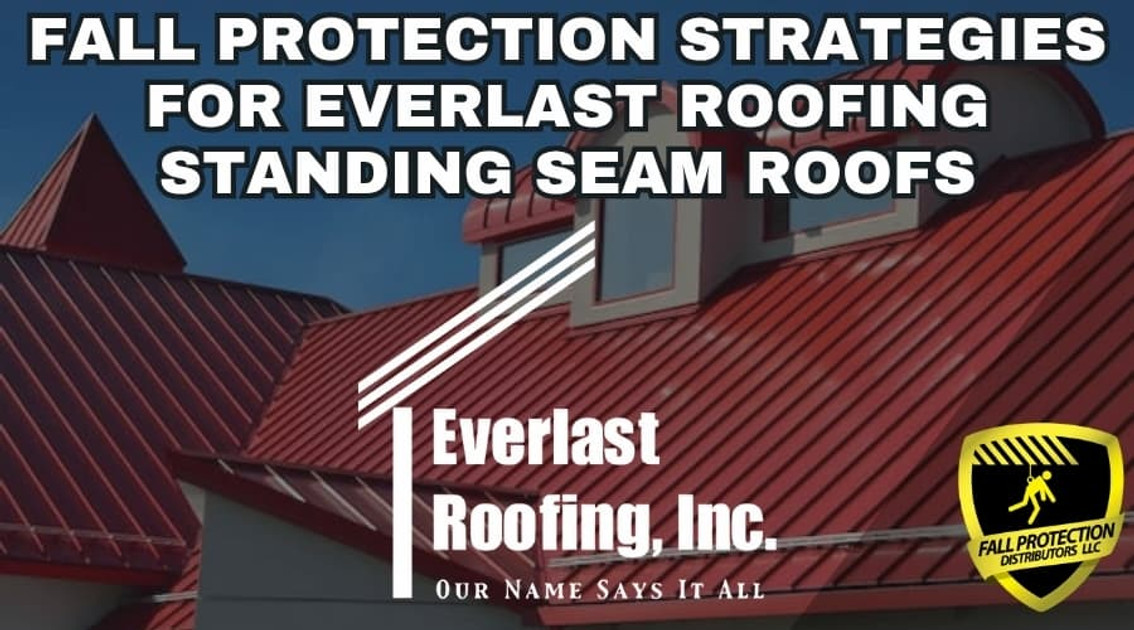Fall Protection Solutions For Everlast Roofing Panels
Posted by Howie Scarboro - CEO Fall Protection Distributors, LLC on Oct 23rd 2025
See the Roof Anchor Compatibility Chart for Everlast Roofing Standing Seam Panels.

Who Is Everlast Roofing?
Everlast Roofing, Inc. has grown from a small family operation in Ephrata, Pennsylvania, into one of the most respected names in the metal roofing industry.
Founded in 1997 with just four employees serving the agricultural market, the company quickly expanded its reach by focusing on quality, reliability, and continuous improvement. Today, Everlast is the second-largest manufacturer of metal building products in the Northeast and Mid-Atlantic regions.
The company's recent expansion through the acquisition of Metal Roofing Solutions in Bridgton, Maine, and the addition of a new manufacturing facility in Indiana have strengthened its ability to serve customers in the Midwest. With three advanced manufacturing plants now operating nationwide, Everlast produces more than 18 million linear feet of roofing and siding products each year.
Innovation remains the foundation of Everlast's success. Proprietary technologies such as AZM coatings and ColorBond finishes give their panels superior corrosion resistance and long-term color retention. These advancements extend the lifespan of every product while reducing maintenance costs for building owners. Everlast's product range includes everything from rugged agricultural profiles to refined architectural standing seam systems, all built to meet demanding project requirements.
This article focuses on working safely with Everlast Roofing's standing-seam metal panels. Each roof system offers unique structural and aesthetic advantages, but they all share one essential need—proper fall protection. By understanding which non-penetrating anchors and safety systems work best with each panel profile, contractors and building owners can protect both their crews and their investments.

Why Are Non-Penetrating Seam Anchors Necessary for Everlast Roofing's Standing Seam Panels?
Standing seam metal roof panels connect with concealed clips that allow the seams to float freely as temperatures rise and fall. This ability to expand and contract is what gives standing seam systems their exceptional watertight performance. The moment someone drills into a panel or drives a fastener through the surface, that design advantage disappears.
A single penetration can compromise the factory-applied coating and expose the underlying metal to moisture. Over time, that moisture seeps into the insulation or decking below, leading to severe damage.
Beyond water intrusion, penetrations can also disrupt the roof's smooth, uniform appearance. When screws or bolts apply uneven pressure to a standing seam panel, they can distort the surface, resulting in visible waves in the metal known as oil canning. This warping doesn't always affect structural performance, but it can ruin the roof's appearance. Once oil canning occurs, it's nearly impossible to correct without replacing the affected panels.
Non-penetrating seam anchors eliminate these risks. Instead of drilling, they clamp securely to the seams using non-penetrating set screws that apply even pressure without crushing the metal. This method maintains the integrity of the roof while creating a safe, 5,000-pound-rated tie-off point that meets OSHA and ANSI standards.
In short, non-penetrating anchors protect what makes standing seam roofs so valuable in the first place: long-term durability, flawless appearance, and total weather resistance.
Everseam Snaplock Panels

The Everlast Roofing Everseam panel combines timeless architectural appeal with modern strength, delivering the classic look of a standing seam roof built from durable 24-gauge steel.
The durability of Everseam panels lowers maintenance costs. It extends the roof's service life, making it a long-term investment for homeowners and contractors alike. With more than a dozen colors and finishes available, the Everseam panel creates a refined, designer-grade appearance that boosts curb appeal and adds resale value to any property. See the Roof Anchor Compatibility Chart for Everlast Roofing Everseam Snaplock Standing Seam Panels.
The Everseam Snaplock system features a 1½ inch seam height and a 20-inch panel width, secured with concealed metal clips that eliminate exposed fasteners. The integrated locking seam provides a clean profile and prevents water infiltration, allowing the system to perform reliably on roof pitches as low as 3:12. Its combination of strength, longevity, and visual appeal makes the Everseam one of the most versatile standing seam panels in the Everlast lineup.
Fall Protection for Everseam Snaplock Panels
Working safely on Everseam panels requires fall protection systems that do not penetrate or deform the seams.
For 24-gauge steel applications, the SSRA1 Standing Seam Roof Anchor provides a reliable 5,000-pound-rated tie-off point without compromising the watertight surface. It clamps directly to the seams using twelve non-penetrating set screws, preserving the finish and maintaining OSHA and ANSI compliance. The SSRA1 installs quickly with a micro torque wrench. It can be reused across multiple jobs, making it an efficient and safe solution.
When crews need level working surfaces, they can mount SSRA2 Adjustable Roof Jack Adapters atop SSRA1 anchors to support 10-foot wooden walkboards. Their adjustable side legs accommodate the seam height of the Everseam panel, providing a secure, level work platform for installation and maintenance tasks.
For larger or more complex projects, the SSRA3 Anchor Plate can connect two SSRA1 anchors to serve as end points for temporary horizontal lifelines. When combined with the Malta Dynamics HLL3001 Horizontal Lifeline System, this setup provides 100 feet of continuous tie-off coverage for up to two workers. It's one of the most versatile systems available for standing seam roofs, giving crews the freedom to move safely across long roof sections while maintaining compliance and protecting the panel surface.
For permanent access and maintenance applications, the Super Anchor 120-foot Permanent Standing Seam Horizontal Lifeline Kit offers a long-term, non-penetrating solution. This system installs on the seams to create fixed tie-off points that remain in place year-round. It ensures that service crews, inspectors, and maintenance teams can clip in immediately upon arrival, maintaining complete safety without compromising the roof's warranty or appearance.
For steep roof slopes between 6:12 and 12:12, the Ridge Pro Steep Assist Anchor remains the preferred choice. It installs from the ladder using a 16-foot extension pole. It hooks securely over the ridge to create a stable tie-off point before workers step onto the roof. This method provides a 100 percent tie-off from ladder to ridge and back down again, protecting both the worker and the Everseam panel.
By combining Everlast Everseam panels with compatible non-penetrating systems such as the SSRA1, SSRA2, SSRA3, Malta Dynamics HLL3001, Super Anchor 120-foot Permanent HLL Kit, and Ridge Pro Steep Assist Anchor, contractors can achieve total jobsite safety while preserving the watertight design and architectural finish that define the Everseam Snaplock system.
Everloc Nailstrip Panels

The Everlast Roofing Everloc Nailstrip panel blends a classic standing-seam style with modern installation efficiency.
Made from durable 26-gauge steel, this panel provides the look of a high-end architectural roof without the need for mechanical seaming or separate clips. Instead, it installs easily over a solid, waterproof substrate using a nail flange that allows the metal to expand and contract naturally with temperature changes. The result is a strong, watertight system that maintains its sleek profile year after year. See the Roof Anchor Compatibility Chart for Everlast Roofing Everloc Nailstrip Standing Seam Panels.
Each Everloc panel measures 16 inches wide with a 1-inch seam height. The concealed-fastener design eliminates visible screws, reducing the risk of leaks. The interlocking side lap keeps water out even on lower slopes starting at 3:12. At the same time, the high-strength galvalume steel construction provides exceptional corrosion resistance in all climates.
The Everloc panel also features Everlast Roofing's proprietary Synergy finish, a coating system that delivers impressive long-term protection. It carries a 40-year warranty on film integrity, a 30-year warranty against fading or chalking, and a 25-year performance guarantee on the acrylic-coated AZ55 substrate. With minimal maintenance and lasting visual appeal, the Everloc Nailstrip panel offers outstanding value for residential, mansard, and fascia applications.
Fall Protection for Everloc Nailstrip Panels
Because the Everloc panel material is 26-gauge steel, it cannot safely support seam-mounted anchors such as the SSRA1, SSRA2, or SSRA3.
The lighter panel material does not provide sufficient strength to withstand possible impact loads from a fall. To ensure worker safety while maintaining roof integrity, crews should use ridge-mounted fall protection systems that do not rely on seam attachment.
For roof pitches between 6:12 and 12:12, the Ridge Pro Steep Assist Anchor provides a reliable, non-penetrating tie-off point. It installs from the ladder using a 16-foot extension pole. It hooks securely over the ridge, allowing workers to attach a vertical lifeline before stepping onto the roof. This setup maintains a 100 percent tie-off from ladder to ridge and back down again while preserving the Everloc system's watertight design.
The Ridge Pro Steep Assist Anchor is especially effective for contractors performing inspections, maintenance, or small-scale repairs on Everloc roofs. It ensures OSHA compliance without damaging the panels or voiding warranties, making it the most practical safety solution for this profile.
By combining Everloc Nailstrip panels with non-penetrating ridge-mounted systems like the Ridge Pro Steep Assist Anchor, contractors can maintain complete worker safety while protecting the roof's clean architectural look and long-term performance.
Standing Seam Roof Anchor Compatibility For Everlast Roofing Panels
| Everseam Snaplock 24 ga. | Everloc Nailstrip 26 ga. Panels | |
|---|---|---|
SSRA 1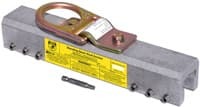 |
NO | NO |
SSRA1 Nylon Tip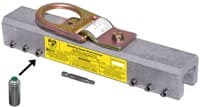 |
YES | NO |
SSRA2 Roof Jack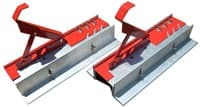 |
YES | NO |
SSRA3 Anchor Plate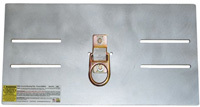 |
YES | NO |
The Ridge Pro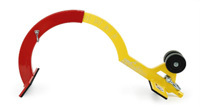 |
YES | YES |
Contact Us For More Information
For further details on roofing solutions and fall protection systems, contact us at 863-703-4522 or www.StandingSeamRoofAnchor.com. Let's work together to make your roofing projects safe, beautiful, and built to last. For more safety tips, refer to OSHA's 48-page Fall Protection Manual. Once you have determined the most suitable anchors for your roof system, download our free Anchor Inspection Form.
Safety Tips For Standing Seam Roofs
Promote a Culture of Safety
Safety starts long before anyone ties off. It begins with open communication, honest accountability, and a team that looks out for one another. When workers share lessons from close calls and speak up about hazards, safety stops being a rule and becomes second nature. The best crews treat every workday as a group effort to get everyone home safe.
Prioritize Ladder Safety Training
The climb to the roof is often where the real danger begins. Workers should inspect ladders for cracks, worn feet, or loose rungs before every use. The 4-to-1 rule keeps ladders stable, and maintaining three points of contact keeps workers secure. A few extra seconds spent setting a ladder correctly can prevent injuries that change lives.
Equip Workers with High-Quality Safety Gear
Confidence on the roof depends on trust in the gear. A harness that fits comfortably, a lifeline that moves smoothly, and connectors that hold fast allow workers to focus on their task instead of their equipment. Regular inspections catch minor issues before they turn into failures. With OSHA's 2025 rule requiring individually fitted harnesses and lanyards, proper sizing is no longer optional—it's the law.
Develop OSHA Compliant Safety Plans
A well-written safety plan doesn't just meet regulations; it saves time and lives. It defines tie-off points, details rescue steps, and assigns responsibility so no one hesitates when it matters most. The best safety plans are clear, easy to follow, and updated regularly to reflect changing site conditions. Preparation gives crews the confidence to react quickly and stay safe under pressure.
Ensure Proper Footwear for Stability
Secure footing is the foundation of safe roofing. Metal panels can be slick, especially when dusty or wet. Roofing boots with special tread and firm ankle support provide the grip and balance needed to move confidently. The right pair reduces fatigue, improves traction, and helps make every step safe.
Install Permanent Roof Anchor Systems
Buildings that need regular maintenance benefit from long-term anchor systems. Once installed, permanent anchors provide instant tie-off points for service crews or inspectors. They remove the guesswork of temporary setups, reduce installation time, and preserve the roof's appearance.
Use Specialized Anchor Systems for Standing Seam Roofs
Standing seam roofs require anchors that grip seams without piercing them. Clamp-style anchors, such as the SSRA1, create strong tie-off points while preserving the roof's watertight design and warranty coverage. Avoid anchors that depend on locating clips beneath the seams, as those clips are nearly impossible to find once the roof is complete. The right system protects both the worker and the investment beneath their feet.
Encourage the Use of Trauma Straps
A harness may stop a fall, but it's the trauma straps that can save a life afterward. Hanging motionless in a harness restricts blood flow within minutes, leading to suspension trauma. Trauma straps allow a worker to stand and relieve pressure while waiting for help to arrive. They're lightweight, inexpensive, and essential on every job that involves a harness.
Consult Experts for Curved Metal Panels
Curved and radius roofs require a careful eye and expert input. The shape and slope can change how anchors hold and how lifelines perform. Before anyone steps onto a curved standing seam surface, a fall protection specialist should inspect the roof and recommend a proper plan. That small investment in expertise prevents costly damage and protects lives.
Set Up Protective Guardrail Barriers for Work Zones
Guardrails quietly do their job in the background, offering protection before anyone ever clips in. Around skylights, roof edges, or roof openings, they create visible boundaries that stop slips and missteps before they happen. A well-placed guardrail doesn't just prevent falls; it defines safer, more organized work zones that keep everyone focused on the task at hand.
Disclaimer
The views, recommendations, and information presented in this blog are solely those of the author and do not necessarily reflect the opinions or positions of the featured panel manufacturer, its brands, subsidiaries, or parent companies. Customers are strongly encouraged to contact the roof panel manufacturer directly for inquiries regarding fall protection compatibility with their products and to address any potential warranty issues that may arise after installing our products.

